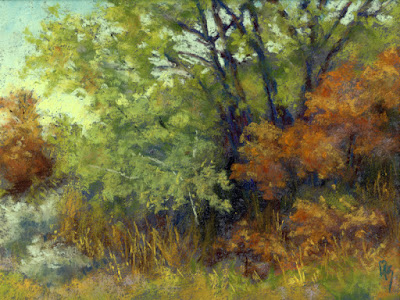I decided I need to get back into some form of hiking shape, for two reasons; 1. for my health, 2. to spend more time in nature. So, the plan is to go hiking once/week weather permitting and get in plenty of walking time in during the week. Maybe by the end of the season I'll be able to hike uphill for more than 100 yards without running out of breath. Of course if I'm going to be out in the mountains sketching must happen, as a bonus carrying a backpack full of sketching supplies and equipment (16 lbs worth!) adds to the work out. The Wasatch Mountain canyons are just a 10-15 minute drive from my house, of course this easy accessibility to the mountains from a heavily populated valley means you've got to get up early to get a parking spot at the trailhead. I arrived at the "Mill B" trailhead parking lot by 7:00 am and the primary parking lot was already mostly full. It was a little cool for comfort that early in the morning but bearable, I knew the hiking would get me warm soon enough.
My first sketch was by where a tributary creek empties into Big Cottonwood Creek, this sketch is of a small waterfall in Big Cottonwood Creek and was done in charcoal in a Stillman and Birn Beta 9x12 sketchbook;
I'm not sure I care for the paper in the Beta sketchbook for charcoal drawing, or maybe it was just my lack of experience with working with charcoal on location, I may have to adjust my technique.
Next, all I had to do was turn around walk a couple steps, sit on a rock and sketch this scene by the tributary creek with a large pine tree leaning over the creek. The tree seemed to have sprouted out of a pile of rock. I used a 7" X 10" Stillman and Birn Zeta sketchbook and pen for this sketch.
The paper in the Zeta sketchbook is thinner and much smoother than the Beta, it was great for pen work, the pen flowed very smoothly, very little resistance which helped to sketch a very complicated scene quickly.
Finally I got to hiking up the actual "Mill B" trail. Previous to this I'd just walked up a paved pathway, it was uphill but nothing too strenuous. The "Mill B" trail is very rocky in spots and can be challenging to climb, especially for a heavy, old guy with bad knees but I made it easy enough to my next stop, another small waterfall.
Even though the paper in the Zeta sketchbook is fairly light it takes watercolor very well, I didn't experience any buckling, however I didn't put down any large, heavy and wet washes. The watercolor seems to more sit on top of the paper than be absorbed by like it would be real watercolor paper but it worked just fine. I combined the watercolor with some pen work. I held the sketchbook and watercolor palette with one hand and used a waterbrush to paint with the other. However this sketchbook is larger and heavier than the sketchbook I used to use for this and my left hand tired easily. I'll have to use my homemade stand next time.
I managed to hike up the trail quite a ways but I didn't want to overdo it on my first outing of the year. I could tell I was reaching what should be my limit for the day when I spotted the perfect rock to sit on and sketch just off the trail so I walked up to it and looked back to see if there was anything worth sketching, I decided the view back down the trail was good, though would be a challenge to simplify.
I decided to use charcoal again in the large Beta sketchbook. I was also smart enough to get out the sketchbook stand this time. The stand is just a platform I made that attaches to a small tripod which I also carry. I've been carrying this stuff around the whole time I might as well use it right? There is a trail in that sketch, can you see it? Probably not for all the rocks! Yes, you have to scramble over the rocks as part of the trail, it can get a bit challenging at times, especially on the way back down.
Well, it was a good first "hike and sketch" outing for the year. I hiked further than any day I did last year and it wore me out pretty good but I didn't push it too hard. Hopefully I'll make a weekly habit of this and actually lose some weight and be in some semblance of hiking shape by fall.















































